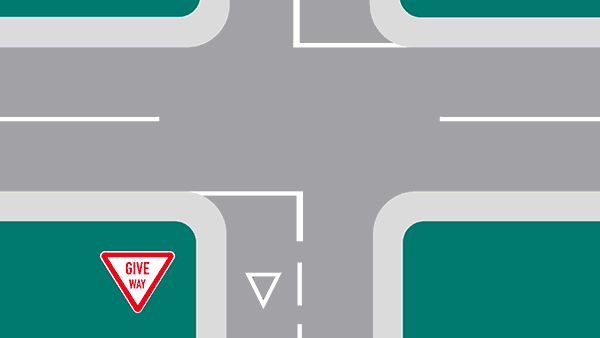Intersections can seem tricky at first so it's a good idea to master this in stages.

Where should you practise this?
Start with easier intersections that aren't too busy and only have one lane of traffic in each direction. Once you are ready move on to busier more difficult ones
When you are practising, include a variety of T-intersections and crossroads. Make sure you try intersections with:
- traffic flowing through it, so you can practise picking gaps
- traffic lights
- Give Way signs
- Stop signs
- or uncontrolled intersections.
Why is this different from doing a left turn?
When you go straight at a cross-roads intersection, or turn right, you’ll need to check two lanes for traffic.
As you come up to the intersection
- Look ahead to plan how you’re going to position your car.
- Follow the intersection approach routine: mirrors, indicate, course, brake, gear, assess.
- Position your car so you’re pointing straight ahead, next to the centreline.
- Follow any give way rules that apply.
- Check in both directions – you need to pick a big enough gap in the traffic coming from both your right and your left to get through (if going straight ahead) or move into (if turning right).
- Before you move off, remember to check where your car will be once you’ve made the turn. Is it clear?
- As you begin to move off, do one last check right and left in case there’s something you missed before.
- Once you’ve turned, speed up smoothly so that you’re going at a similar speed to the cars around you.
Tips for right hand turns or driving straight through at intersections
- Watch out for turning lanes marked on the road, and choose the correct lane for where you want to go.
- If there’s a Stop sign, you must come to a complete stop. If you don’t it could be a critical or immediate failure error in the test.
- When stopping behind traffic at an intersection, give yourself some room in front of your car. You want to be able to see a bit of road over your bonnet.
- Be ready to give way, even if you’re not meant to – other drivers might make mistakes picking a gap.
- In your test, the Testing Officer will be looking for you to pick the first available safe gap.
- If you decide it’s not safe to go, stop. You can change your mind if you need to.
Are you test ready?
Question

Next skill